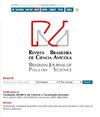被动生物声监测在城市公园噪声污染调查中的应用
IF 1.1
4区 农林科学
Q3 AGRICULTURE, DAIRY & ANIMAL SCIENCE
引用次数: 0
摘要
一个地方的声学景观是由生物声、人声和地声组成的。生物声包括生物,主要是动物在交流时发出的声音;地学由地球物理环境的声音组成,比如河流、雨水和瀑布。在这个案例研究中,我们评估了被动生物声监测在巴西贝洛奥里藏特城市公园检测人为污染的有效性。我们使用了野生动物声学的SM2+型录音机,录音机被配置为接收高达20赫兹的声音。每个记录仪固定在离地1.5 m的树上,每棵树上使用2个麦克风。将采集到的数据提交到广义线性模型检验(GLMM)中,结果表明人为噪声对鸟类发声有很强的影响。我们的研究结果证明了该方法的有效性,并指出需要制定公共政策来减轻城市公园噪音污染的影响。本文章由计算机程序翻译,如有差异,请以英文原文为准。
Passive bioacoustic monitoring as a method to investigate noise pollution in urban parks
The acoustic landscape of a place is formed by biophony, anthropophony and geophony. Biophony comprises the sounds produced by living beings, mainly animals during their communications; geophony consists of the sounds of the geophysical environment, like a river, the rain and waterfalls. In this case study, we evaluated the effectiveness of passive bioacoustic monitoring in detecting anthropogenic pollution in an urban park in Belo Horizonte, Brazil. We used the Song Meter recorder model SM2+ from the Wildlife Acoustics, the recorders were configured to receive sounds of up to 20 Hz. Each recorder was fixed in trees 1.5 m above the ground and 2 microphones were used in each of them. The collected data were submitted to the Generalized Linear Model Test (GLMM), which resulted in a strong influence of anthropic noises on the birds' vocalization. Our results demonstrate the effectiveness of the method and point to the need for the development of public policies to mitigate the effects of noise pollution in urban parks.
求助全文
通过发布文献求助,成功后即可免费获取论文全文。
去求助
来源期刊

Brazilian Journal of Poultry Science
农林科学-奶制品与动物科学
CiteScore
1.80
自引率
9.10%
发文量
60
审稿时长
>12 weeks
期刊介绍:
A Revista Brasileira de Ciência Avícola surgiu em 1999 a partir da necessidade que a comunidade científica possuía de um periódico para veiculação e publicação de seus trabalhos, com a publicação de três números anuais.
A Revista conta hoje com um corpo editorial altamente qualificado e com artigos científicos desenvolvidos pelos maiores especialistas da área, o que a cada dia atrai mais leitores em busca de inovação e respaldo técnico.
Devido à credibilidade que conquistou pelos esforços de sus autores, relatores e revisores, a Revista ganhou caráter de coleção, sendo consultada como fonte segura de estudo desenvolvidos na Avicultura.
A partir de 2003 – volume 5 -, a Revista passou a chamar-se Brazilian Journal of Poultry Science, e todos os trabalhos passaram a ser publicados em inglês. No mesmo ano subiu para quatro o número de revistas por volume, ampliando-se assim os trabalhos publicados anualmente.
 求助内容:
求助内容: 应助结果提醒方式:
应助结果提醒方式:


